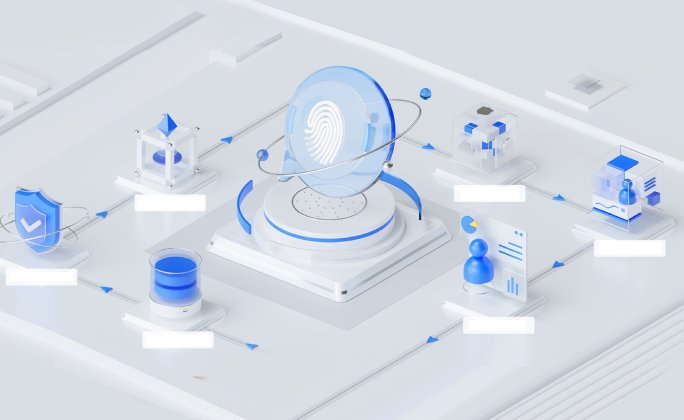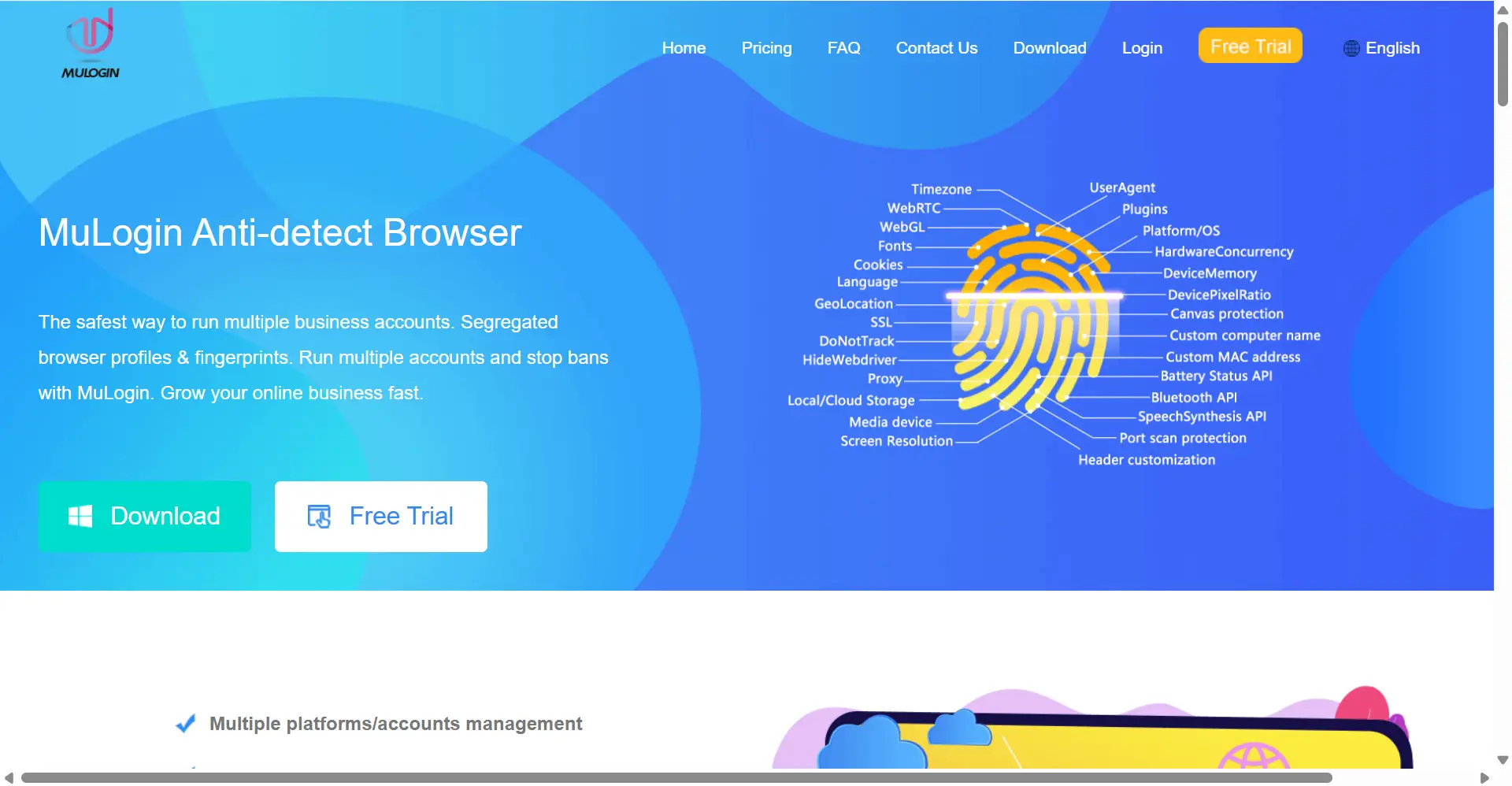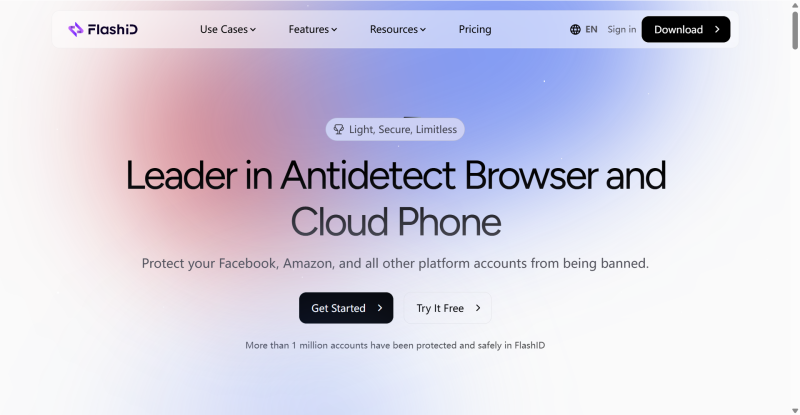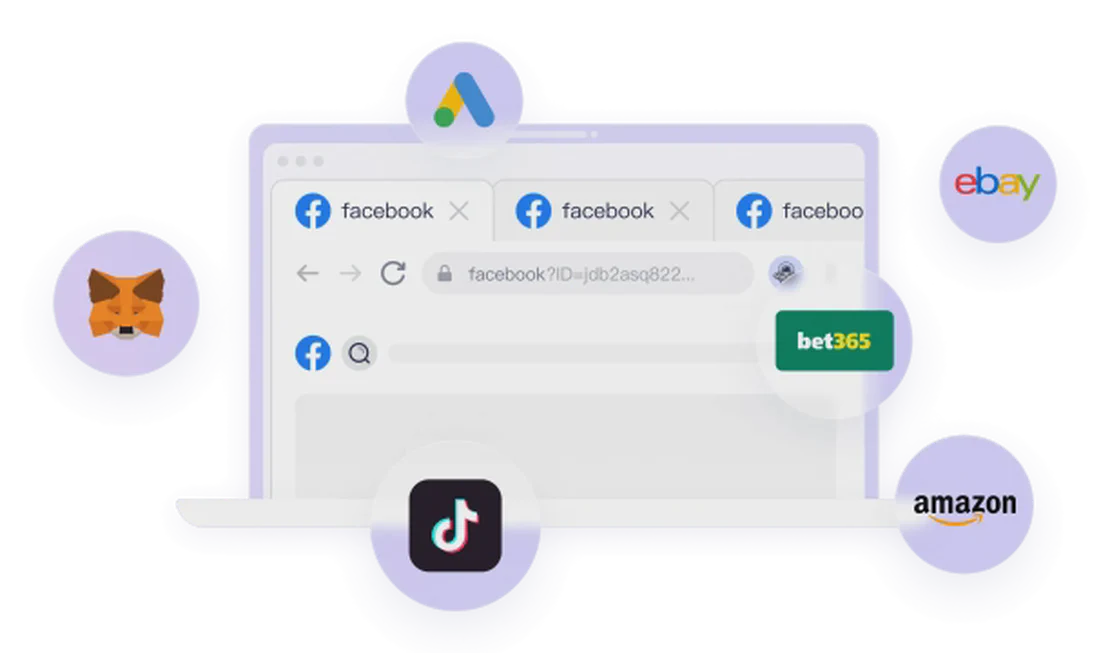In the battlefield of digital identity management, certain tools become legendary for their sheer professionalism within a niche domain. MuLogin is one such name. With its stable, reliable, and highly efficient browser environment isolation on the desktop, it has become the “desktop fortress” for countless cross-border e-commerce sellers and marketers. Users trust it like a safe, providing an impregnable sanctuary for hundreds or even thousands of independent e-commerce and marketing accounts, ensuring they can coexist on a single physical device without interfering with one another.
However, the tide of business is always surging forward. Today, successful digital operations are no longer a game won by simply garrisoning troops within a single fortress. The frontlines of traffic have expanded from the desktop to the vast mobile universe, and the weapons of efficiency have evolved from basic “identity masking” to “intelligent automation.” When we survey this rapidly changing battlefield, we must recognize with clarity: how can a fortress, content to only defend its walls, hope to victory in a future war that requires cross-platform operations and rapid, automated offensives?
Today, we place the “master of desktop defense”—MuLogin—against an “omnipotent battle god” capable of both offense and defense—FlashID. Let’s see whose arsenal of tools can truly strike the right chord for the future of business.

MuLogin: The Impenetrable Desktop Identity Fortress
The success of MuLogin lies in its profound understanding and perfect solution to the core pain point of desktop-based multi-account operations: secure isolation. It doesn’t pursue flashy features; instead, it has perfected this one core function to the extreme.
Product Introduction & Use Cases MuLogin is a software dedicated to isolating and managing numerous browser profiles on a single computer. By creating a completely independent OS environment for each profile, it ensures that information like Cookies, Canvas, WebGL, and hardware fingerprints cannot leak between them, thus fundamentally eliminating the risk of account association. This makes it excel in the following scenarios:
- Cross-Border E-commerce: Creating isolated, untraceable browser environments for different Amazon, eBay, and standalone stores is a top choice for many sellers.
- Social Media Marketing Matrix: In a compliant manner, managing numerous Facebook and Google Ads accounts and other web-based social media profiles.
- Data Scraping and Crawling: Isolating digital fingerprints for different crawling tasks to prevent detection and blocking by target websites.
Integration & Convenience MuLogin’s integration logic is purely about encapsulating and managing the Chromium kernel browser. Users can, just like with a regular Chrome, install extensions and perform logins and operations within each isolated profile. Its clean, focused interface allows users to get started quickly and focus on the task at hand.
Core Strengths MuLogin’s greatest strength is its stable and pure desktop environment isolation capability. The “fortress” system it has built on the desktop has been tested by countless users over a long period, earning it a sterling reputation for reliability and security among its peers.
Inherent Limitations & Challenges However, this “impregnable desktop fortress” has moats it cannot cross:
- Complete Blank in Mobile App Support: This is MuLogin’s most fundamental strategic shortcoming. As apps become the primary battleground for traffic and conversion (e.g., TikTok, Instagram, Pinduoduo), MuLogin’s users are forced to shuttle back and forth between the powerful “desktop fortress” and their vulnerable “real devices.” This fragmentation is not only inefficient but also significantly increases the risk of exposing mobile accounts, rendering the “security” advantage of the desktop moot.
- Severe Lack of Automation Capabilities: MuLogin focuses on “defense”—providing secure isolation—but it seriously lacks “offensive” capabilities, namely automated workflows. It cannot achieve data synchronization between different profiles, nor does it have a built-in RPA engine to execute tasks like posting, commenting, or placing orders. Every step requiring “manual” handling must be done by switching profiles manually, creating a massive efficiency bottleneck.
- Simplified, Single-Model Business Approach: The positioning of MuLogin makes it a “single-point tool.” It has pushed desktop account management to its limits but cannot offer users a unified platform to manage mobile-side business. Users who want to expand their operations must purchase a second mobile management tool, leading to increased costs, cumbersome operations, and an inability to create synergies.
Market Feedback & Reviews Among user groups heavily reliant on “manual” PC operations, MuLogin enjoys an excellent reputation, hailed as a “divine tool.” However, as business tilts toward mobile and the desire for efficiency grows, more and more users are complaining, “I have to manage apps on a real phone, it’s such a hassle” and “Can it help me automate some clicks?” The market demand is shifting from “security” to “security + efficiency + all-scenario.”

FlashID: Breaking Boundaries, Reshaping the New Paradigm of Digital Operations
Faced with the limitations of “single-point breakthrough” tools like MuLogin, FlashID’s mission is to break down platform barriers and redefine the concept of digital operations. We believe that the winners of the future will be individuals and teams that can seamlessly connect all operational scenarios and empower every link with intelligent automation.
Product Introduction & Key Features FlashID is a revolutionary integrated platform that combines a top-tier fingerprint browser with a native Android Cloud Phone. It’s not content with just being better on the desktop; it aims to cover every operational scenario a user might encounter. It not only allows you to manage accounts via a browser but also supports managing them through an Android cloud phone.
Core Advantages & Use Cases FlashID’s strengths are systematic and forward-looking, designed to build a complete, closed-loop business operation:
- Full-Scene Coverage, Ending Scenario Fragmentation: FlashID’s most core innovation is the deep integration of a powerful desktop fingerprint browser with a fully functional Android Cloud Phone. This means you can not only build an impregnable PC “fortress” in the cloud but also directly control independent, real Android systems within these fortresses to run any mobile app. The Window Sync feature simplifies your workflow by synchronizing operations across multiple browser windows and cloud phone instances. This is “frontline and rear-area integrated” warfare that MuLogin can never imagine.
- Full-Process Automation, Triggering an Efficiency Revolution: FlashID doesn’t stop at “isolation”; it targets “efficiency” directly. Its built-in RPA automation engine, combined with the Window Sync capability, can create powerful, cross-platform automated workflows. For example, an RPA task could: post a Xiaohongshu note on a PC browser -> sync to automatically post the video on a TikTok App on a cloud phone -> then sync to an Instagram Story for promotion. This automation saves labor costs and is an essential tool for online ventures.
- Enterprise-Grade Collaboration, Supporting Scalable Growth: FlashID is built for teams and scalable operations, offering a comprehensive team collaboration and management system. Granular permission allocation and detailed operation logs make multi-account operations orderly and auditable.
- The Unification of Security and Efficiency: FlashID also possesses top-tier environmental isolation and fingerprint spoofing capabilities, inheriting the security DNA of tools like MuLogin. More importantly, it extends this security to the mobile realm. The browser solves web-based multi-account scenarios, while the cloud phone solves Android mobile multi-account scenarios (the cloud phone runs on Android), achieving true all-scene security.
Integration & Convenience FlashID employs a unified web console where creating desktop profiles, starting a cloud phone instance, or building an automation workflow all happen within the same interface. This cloud-native experience means management and operation are no longer confined to any specific physical device; you have control anytime, anywhere.
Product Positioning & Future Prospects FlashID is positioned as a “closed-loop” solution for the future. It aims not to solve the “single-point security” problem but to provide a complete business ecosystem from PC to mobile, from isolation to automation, and from individual tasks to team collaboration. Its direction of development is always in sync with emerging trends in the digital world.

The Ultimate Showdown: MuLogin vs. FlashID Feature Comparison Table
To give you a clearer view of their strategic differences, here is the detailed comparison table:
| Feature Category | MuLogin | FlashID | FlashID’s Decisive Advantage |
|---|---|---|---|
| Core Positioning | ❌ An intensely focused desktop security fortress | ✅ An all-scene, automated digital identity management platform | From “single defense” to “all-scene, integrated offense and defense,” a strategic strategic advantage |
| Platform Support | ❌ PC websites and browsers only | ✅PC websites + Full-featured Android mobile apps (Cloud Phone) | The only platform capable of effectively solving mobile multi-account security and operations, creating a business loop |
| Environment Isolation | ✅ Core strength, high-quality desktop isolation | ✅Advanced fingerprint spoofing + Powerful env. cloning + Cloud OS isolation | Broader isolation dimensions, covering PC fingerprints and mobile devices, a more complete security system |
| Mobile Support | ❌ Completely unsupported, business flows to real devices | ✅Powerful Android Cloud Phone, running any native mobile app | Brings mobile operations into unified security management, completely solving mobile operational pain points |
| Automation | ❌ No native automation, relies on third-party scripts with poor compatibility | ✅Window Sync + Built-in RPA engine | From “pure manual operation” to “cross-platform intelligent automation,” achieving an exponential leap in efficiency |
| Team Management | ❌ Weak features, suitable for individuals or small teams | ✅Enterprise-grade team spaces with granular permissions & operation audits | From “small workshop” to “standardized management,” supporting scalable business growth |
| Workflow Synergy | ❌ Profiles are isolated and cannot collaborate | ✅Cross-device, cross-application window sync & workflow integration | Breaks down app isolation, enabling smooth data and operation flow, a vastly superior experience |
| Deployment Model | ❌ Confined to a local physical PC | ✅Cloud-based console, manage and operate anytime, anywhere | A true cloud-native experience, freeing productivity, independent of specific devices |
| Use Case Scalability | ❌ Severely limited to PC desktop scenarios | ✅ Covers all mainstream scenarios: affiliate marketing, cross-border e-commerce, social media, scraping, traffic arbitrage, crypto | One platform solves all scenarios, no need to buy different tools for different platforms |
| Tech Evolution Dir. | ❌ Relatively outdated tech stack, slow iteration | ✅ Continuously integrating cutting-edge tech (e.g., RPA, cloud-native),leading industry development | Choosing FlashID means choosing continuous technological advantage synchronized with the future |
Conclusion: Choose the “Fortress” or the “Future”?
The verdict is clear after this showdown.
MuLogin is an excellent “classic” tool. It achieved perfection during a specific period (the PC-dominated era) and in specific scenarios (desktop security). If you are an individual developer whose business will never touch apps and who has zero need for automation, then MuLogin’s “safe” might suffice. But this is a gamble that your battlefield will never change.
FlashID is purely a “modern” and “future” tool. The all-scenario, integrated operational ecosystem it has built perfectly aligns with all core demands of modern digital business. It not only solves your security problems but also helps you solve problems of efficiency, mobile operations, collaboration, and even problems you haven’t foreseen in the future.
Frequently Asked Questions (FAQ)
Q: 95% of my e-commerce business is on PC backends like managing Amazon and Wish stores. MuLogin does a great job with desktop security. Why should I switch to FlashID?
A: Even though 95% of business may be on PC, the “traffic entry points” for modern e-commerce ecosystems are on mobile devices. For example, driving traffic to your independent store through TikTok or Instagram videos and posts, or responding to customer inquiries on mobile phones. MuLogin can’t help you manage these mobile social media accounts, nor can it safely log into seller backends on mobile. FlashID’s Android Cloud Phones allow you to run all these apps in a securely isolated environment, while the Window Sync feature lets you see real-time feedback on the cloud phone while operating on PC, enabling integrated image-text marketing - something MuLogin completely cannot do.
Q: I have over a hundred accounts isolated in MuLogin with all my data in it. Would migrating to FlashID be a huge hassle?
A: We completely understand your concern. FlashID was designed with smooth migration in mind. We will provide detailed migration guides and one-on-one customer support. The migration process mainly involves re-creating the corresponding fingerprint profiles in FlashID after organizing your account information. Because FlashID’s isolation capabilities are stronger and its integration is higher, you’ll find that your operational efficiency and security will be significantly improved after the migration.
Q: I don’t need complex advanced automation; I just want to sync logins and operations across multiple windows. Can FlashID do that?
A: This is precisely one of FlashID’s most fundamental and happiness-boosting features—Window Sync. It’s incredibly simple; for example, if you log into Amazon in Browser Window A and change the price, this login state and action can be instantly synchronized to Window B, Window C, or even the Amazon App on a cloud phone. This small feature alone can save you a massive amount of time on repetitive logins and operations, making it a powerful tool for efficiency.
Q: I mainly use MuLogin to manage Google and Facebook ad accounts. Does FlashID have an advantage here?
A: The advantage is enormous. You can not only use FlashID to securely manage the creation and login of hundreds or thousands of ad accounts but also combine it with its RPA automation features to automatically create ads, manage bids, and optimize reports. Furthermore, with Window Sync, you can sync a landing page link from an ad campaign to social media for promotion, achieving automated workflows from ad placement to user interaction.
Q: Can a single tool managing both PC and mobile not cause lag or instability?
A: That’s an excellent question. FlashID’s architecture prevents this. The desktop fingerprint browser and the cloud phone run on independent cloud server resources and do not interfere with each other. The client is just a lightweight console responsible for displaying the operational interface and transmitting commands. Therefore, while you powerfully use PC profiles, you can smoothly operate dozens of cloud phones simultaneously without performance or stability issues, far surpassing forcibly running multiple instances on a local computer.
Q: I’m a leader of a small team and am worried that MuLogin can’t scale up. Is FlashID’s team management feature mature?
A: Very much so. FlashID’s team management features are specifically designed for scalable operations. Within a team space, you can assign different account permissions to different members or projects. For example, you can let Group A be responsible only for Amazon accounts and Group B for social media accounts, with their operations isolated and visible. This kind of granular management is incomparable to MuLogin’s shared model and can greatly enhance team collaboration efficiency and security.
Q: My business involves a lot of data scraping. MuLogin is great at anti-detection for scraping. How does FlashID perform in this area?
A: FlashID is just as capable, or even more so, in terms of data scraping security. It not only inherits desktop fingerprint spoofing on par with MuLogin but also provides system-level isolation at the cloud phone level. You can run a browser on a cloud phone to crawl a target website, and the cloud phone’s IP, device ID, and system information are all independent and completely uncorrelated with any operations on your local PC. This “dual isolation” provides a solid shield for your scraping tasks.
Q: I use MuLogin to ensure that the physical isolation of each account is 100% secure. Can FlashID do that?
A: Yes, and in a more modern and thorough way. FlashID achieves 100% isolation through two methods: 1. Fingerprint Camouflage: making each account’s browser fingerprints (Canvas, WebGL, Fonts, etc.) unique, mimicking different devices. 2. System-Level Isolation: If you use cloud phones, each cloud phone instance operates as a separate Android system, ensuring complete isolation from your device and other cloud phones at the kernel level. This is a more secure approach than simple browser environment isolation.
Q: If I’m not familiar with RPA automation, can I still use FlashID?
A: Of course. FlashID has designed different paths for users with different needs. You can:
- Beginner/Casual User: Primarily use fingerprint browser, cloud phone, and Window Sync to improve the efficiency and convenience of managing multiple accounts. These features are very intuitive and require no programming knowledge.
- Advanced User: Can learn to use our visual RPA editor to create simple automated tasks by dragging and dropping modules, which has a very low barrier to entry.
- Enterprise/Developer: Can use our powerful API and scripting capabilities for deep customization to meet the most complex enterprise-level automation needs.
Q: Besides the scenarios mentioned, what else can FlashID be used for?
A: The application scenarios for FlashID are very wide, covering almost all areas that require multi-account management and automation. For example:
- Cryptocurrency Sector: Manage multiple wallet addresses, perform automated interactions and DEX arbitrage, and avoid risk control caused by device association.
- Affiliate Marketing: Use different identities to promote different products to avoid the risk of account suspension from centralized promotion, and improve content output efficiency through automation.
- SNS Traffic Arbitrage: Use hundreds or thousands of accounts to continuously post, comment, and interact on different social platforms to drive traffic to your main account or business.
- Game Multi-clienting: Multi-client games in a cloud phone to automate farming in-game currency or completing tasks.
You May Also Like
